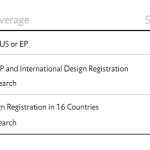A patent is an exclusive right granted for an invention. It enables the inventor to manufacture, use, or sell an invention for a stipulated period in exchange for detailed invention disclosure. Three types of patents are available in the United States, and it has its specifications and durations. It includes utility patents, design patents, and plant patents.
A design patent is a form of legal protection granted to the unique visual qualities of a manufactured item. It is a type of industrial design right. It details the optical ornamental characteristics embodied in or applied to an article. While a utility patent protects the way an article functions, including how it is used and works, a design patent protects its looks. The subject matter of a design patent application will elaborate on the ornamental details of the article, including its configuration or shape, surface ornamentation, or the combination of configuration and surface ornamentation. A design patent exclusively protects the article’s appearance and does not cover its structural or functional features.
You can outsource the solution for researching the prior art references and identify relevant design classification and term sets for your design patent to a US Patent Design Search Service. It helps you rightly register, precise, or invalidate your invention and identify potential infringements and prior art. Your design patent should ideally consist of the following elements.
The Preamble
The Preamble of the design patent application functions as an introduction to the patent claim. It states the applicant’s name, design title, and a brief description of nature and intended use of the article, which embodies the design. If the patentability of the claimed design is approved after examination, the details included in the Preamble are printed on the patent.
Title
The title of a design patent application “identifies the article in which the design is embodied by the name generally known and used by the public, and may contribute to defining the scope of the claim.” It would be best if you did not use marketing designations as the title. It would prove to be helpful for the examiner if the title concisely describes the actual article. It also helps to assign the new application in suitable class, subclass, and patent examiner. A descriptive title also enables the public to understand the use and nature of the article, which embodies the design.
Figure Descriptions
The figure descriptions in the design patent application indicate what each view of the drawings of the article represents. Drawing and illustrations are appropriate for the best description of the design. Specifications can also include certain permissible statements along with the figure descriptions. For example, the words can describe certain portions of the invention’s appearance, which is not included in the drawing disclosure. You can also include descriptions not contained in the Preamble that details the nature and environmental use of the claimed design.
A Single Claim
Typically, a design patent application only includes a single claim. It should define the design that the claimant seeks to patent, which the article embodies. The terminology you use in the title of the invention should consistently follow in the article’s description in the claim. You should write the declaration in formal terms. For example, “The ornamental design for (the article which embodies the design or to which it is applied) as shown.” However, if it includes an accurate description of the claimed design, you can use the term “and described” in the claim, which is preceded by the word “shown.” Thus, the claim reads as “The ornamental design for (the article which embodies the design or to which it is applied) as shown and described.”
Drawings Or Black And White Photographs
In a design patent application, drawing disclosure is of paramount importance. The application for the claimed design must include either its drawing or a black and white photograph. It should constitute the entire visual disclosure of the claim and should be clear and complete. For complete disclosure, the drawings should include an adequate number of views for the appearance of the claimed design. The pictures should be in black ink on the white paper submitted on double-weight photographic paper. You should enter the drawing figure number on the photograph’s face.
The Oath Or Declaration
An oath or declaration in the design patent application must identify the inventor or joint inventor by their legal name. It should also identify the application to which it is directed and include a statement by the person executing the oath or declaration that the named inventor is the original inventor of the claimed design.
To Conclude:
These are the essential elements of a design patent application. You can only make a single claim within the application. While applying with USTPO, you need to pay a filing, search, and examination fee. Since drawings are of critical importance to the design patent application, you need to ensure that the illustrations for the claimed design are of high quality and conforms to the rules set by the Patent Office.





Recent Comments